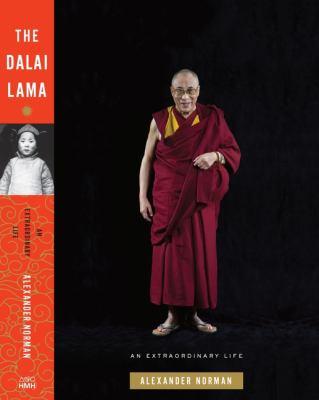
The Dalai Lama : an extraordinary life
The first definitive biography of the Dalai Lama-a story by turns inspiring, surprising-from an acclaimed Tibetan scholar with exceptional access to his subject.
Available Copies by Location
| Location | |
|---|---|
| Stamford | Available |
Browse Related Items
| Subject |
| Bstan-ʼdzin-rgya-mtsho, Dalai Lama XIV, 1935- Dalai lamas > Biography. Tibet Region > Biography. |
| Genre |
| Biographies. |
- ISBN: 9780544416581
- Physical Description xxii, 410 pages : illustrations (some color) ; 24 cm
- Publisher [Place of publication not identified] : [publisher not identified], 2020.
Content descriptions
| Bibliography, etc. Note: | Includes bibliographical references and index. |
Additional Information

The Dalai Lama : An Extraordinary Life
Click an element below to view details:
Excerpt
The Dalai Lama : An Extraordinary Life
It is tempting to begin our story with the first Saturday in July 1935, when, by the Gregorian calendar, the present Dalai Lama was born. And yet to do so would be to ignore the context of that birth. In a way, it would be more accurate to begin with the evening of the seventeenth of December 1933, and the circumstances surrounding it, when the Great Thirteenth Dalai Lama "withdrew his spirit to the Tushita paradise"--where dwell all those on the point of Enlightenment--as pious tradition expresses the matter. The death of the previous Dalai Lama is what precipitates the birth of the next--even if, as in this case, it happens that more than nine months elapse between the two events. Â Yet there is also a case for beginning with the birth of the First Dalai Lama, since, after all, each incarnation is considered to share the same mental continuum. But besides necessitating a long digression into history, this would be problematic. It turns out that the First Dalai Lama was in fact the Third. What happened was that a lama by the name of Sonam Gyatso was summoned by Altan Khan (a descendant of Genghis) to Mongolia, where they met in 1578. Altan, the new strongman of Central Asia, was looking for a way to legitimize his rule, and Sonam Gyatso, as one of the most renowned lamas of the day, looked to be just the person to lend him respectability. Accordingly, Altan, in the idiom of that time, conferred on the Tibetan a number of high-flown titles, one of which pronounced him Dalai Lama. The word dalai is simply a Tibetanization of the Mongolian word for "ocean," which in turn translates the second half of Sonam Gyatso's name. Yet because Sonam Gyatso was in fact the third incarnation of a lineage connected with Drepung, Tibet's largest monastery, it followed that he must, in fact, be the Third Dalai Lama. Â There is an added complication, however. Besides being the third exemplar of the Drepung line, Sonam Gyatso is also considered to have been forty-second in an unbroken lineage going back to the time of the historical Buddha, who lived during the fifth century BCE. It is this lineage that associates the Dalai Lamas with Chenresig, the Bodhisattva of Compassion, whom they are understood to manifest on earth. And yet this lineage is itself antedated by yet another that connects Chenresig with a young prince who lived 990 eons ago. How long is an eon? A disciple is said once to have asked the Buddha the same question. He replied with an analogy: Suppose there were a great mountain of rock, seven miles across and seven miles high, a solid mass without any cracks. At the end of every hundred years, a man might brush it with a fine Benares cloth. That great mountain would be worn away and come to an end sooner than ever an eon. It becomes apparent that, as soon as we start delving into the history of the Dalai Lama, we are faced with the most profound of questions. Indeed, it turns out that, so far as the present Dalai Lama is concerned, we have before us not merely the biography of one man but the story of a being who, from the perspective of his tradition, has been perfected and purified of all defilements through the performance of unnumbered good deeds over countless lifetimes and who manifests here on earth not for his own good but for that of all others. This is, moreover, a story in which the remote past is just the other day and matters supernatural are as real as the natural and as close as right next door. Â To understand the Dalai Lama, therefore, we need to try to catch a glimpse of the world as Tibetan tradition sees it: not as one that began with a single moment of Creation, nor as one where everything might ultimately be expressed as a string of mathematical formulae--a world of atoms and electrons, protons and neutrons. We should not even think of it as a world explicable in terms of quanta and probability. The world as it is understood through the lens of Tibetan tradition did not begin with a big bang which sent the Earth spinning among galaxies and solar systems and ever-expanding space. The world according to Tibetan tradition has no beginning at all. Indeed, the world we see around us exists not on account of atomic or subatomic particles but on account of the accumulated karma of numberless sentient beings over eons of time. Excerpted from The Dalai Lama: An Extraordinary Life by Alexander Norman All rights reserved by the original copyright owners. Excerpts are provided for display purposes only and may not be reproduced, reprinted or distributed without the written permission of the publisher.


